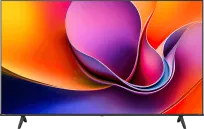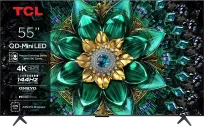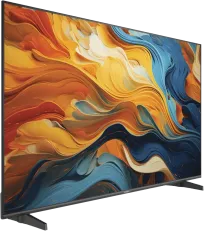
Great colors, very high brightness, and deep, inky blackness. What connects these three features?
Surely, it is that they have nothing to do with the fact that we are talking about a laser projector.
These devices are slowly replacing the well-known lamp projectors, but the marketing of some manufacturers has gone so far that we decided to clarify the issue of lasers.
How does a laser projector work?
What comes to mind when we imagine the operation of a laser projector? It's possible that in our imagination, we envision a device that projects a laser beam directly onto a screen and draws an image pixel by pixel. If that were the case, we would achieve all the features we mentioned at the very beginning. Unfortunately, it doesn't work that way. A much more accurate name is a projector with a laser light source.
This technology replaces the lamp of the projector itself, while the rest of the device remains unchanged.
Thus, in such a projector, we still have an image sensor, a processor, and a lens, and it is these 3 elements that determine the blackness, colors, and especially the sharpness and resolution of the image.
So what will we achieve by replacing the classic lamp with a laser light source?
Blue laser with a phosphor wheel
We can list a few real advantages, but they depend on the type of the given laser.
Currently, there are two such solutions on the market. The first is a blue laser with a phosphor wheel. The principle of its operation is similar to that of an LED bulb. The laser beam excites the phosphor, and white light is produced, which is full-spectrum. To obtain color from it, it must be filtered through a matrix or through a color wheel in DLP projectors.
This solution does not provide more saturated colors than a classic lamp in the projector. For gamers or movie enthusiasts playing 4K content in HDR, we have bad news. This laser does not enrich the color palette so essential for this type of material. It also does not eliminate the rainbow effect in DLP projectors, which many users complain about. This manifests itself in the fact that behind bright contours, we see a rainbow. Of course, each of us may have different feelings about this effect, so it's best to test it ourselves to see if it bothers us before purchasing a DLP projector.
So does the laser with a phosphor wheel significantly improve image quality? Unfortunately, we must state that it does not.
Three-Color RGB Laser
The second solution uses 3 RGB lasers and this design has a real advantage over a lamp.
This is due to the fact that the wavelengths have a narrow band, which automatically provides us with a richer palette of colors, and the DLP color wheel is also unnecessary, meaning the rainbow effect is less pronounced.
In the case of this solution, we can confidently say that it is a better technology than a lamp, considering the two aforementioned issues. However, is the difference really that significant?
The improvement of the rainbow effect can be debatable, as lasers may operate faster than the color wheel, but they don’t have to. In this case, it all depends on the manufacturer.
When it comes to the color palette, the matter is much more complex.
It must be stated that projectors with a three-color laser offer us highly saturated colors, which we cannot achieve by traditional methods. However, it should be taken into account that strong colors are not synonymous with their correct reproduction.
In the case of regular Full HD films, the desired palette is Rec.709
This is ensured by almost every technology currently used in home theater projectors.
When we talk about 4K movies and games in HDR, they utilize a very wide color gamut of BT.2020, which we see below.
Unfortunately, a large portion of the video content available on discs or streaming platforms is limited to the DCI-P3 color gamut, as this is the standard most commonly used by film studios. To fully (or nearly fully) replicate the capabilities of this palette, we need a high-end lamp projector, such as:
Epson EH-TW9400 - 100%
JVC RS540 - 97%
SONY VPL-VW590 - 89%
From what we already know, it's clear that RGB laser is noticeably better than conventional solutions; however, considering the content we play in our homes, this does not translate to a significant gain or leap in quality.
Let's also remember that the ability to achieve vibrant colors has nothing to do with color accuracy or the smoothness of tonal transitions.
These depend on the image sensor and image processor, not the light source, as we mentioned at the beginning of this article.
What technology does the projector use?
Since we already know two technologies, namely the blue laser that adds nothing to image quality and the advanced tricolor RGB, let's see what specific manufacturers can offer us.
HISENSE:
120L9HA - The so-called laser TV or short-throw projector with a screen included. Here we have clear information about the use of RGB laser.
100L5HD - Unfortunately, we do not have clear information about the technology used.
Optoma - This manufacturer does not provide such information on its website. It's a bit strange, and we see no reason to hide the full specifications. However, our keen editorial eyes found a clue in the graphic below.
This photo suggests that a simpler solution with a phosphor wheel is used here, which is confirmed by the data we collected during calibration with our clients.
Epson also does not share such information, but from our experience and measurements, it appears that this manufacturer mostly uses a phosphor wheel, just like Sony and JVC. However, the latter two place additional filters to increase color gamut coverage in the higher models of their products, as well as transducers that do not cause the rainbow effect.
At ViewSonic and Benq, this information is provided directly on the website:
Some manufacturers also offer small projectors that use LED diodes as a light source, and this solution is similar to a tricolor laser.
Durability of Laser vs. Lamp
What is the durability of a laser source like? Manufacturers claim 20,000-30,000 hours before brightness drops by half.
That's many times more than classic lamps, whose lifespan is counted at 3,000-5,000 hours. In practice, brightness drops after just 1,500 hours, and we know cases where customers had to replace the lamp after only 1,000 operating hours.
Unfortunately, we don't have such a research trial in the case of lasers, but among our 2 customers, there was a situation where the source lost a significant part of its power after just under 3,000 hours. In one case, the problem was solved under warranty, but in another case, the entire module was qualified for replacement, which was estimated at...... 20,000 PLN.
As we can see, there is no doubt about the superiority of lasers over lamps in terms of durability, but in the case of a breakdown, the price can give us a headache.
Replacing a lamp costs 800-1,800 PLN, so the cost for 1 hour of viewing is 0.40-0.90 PLN with frequent replacements. Is that a lot? Judge for yourselves.
Power Consumption and Brightness
Let’s tackle another claim made by manufacturers of laser projectors, namely lower power consumption while achieving the same brightness as a traditional lamp.
It's difficult to verify this claim, as there are no two identical devices differing only by the light source. However, if there is such a difference, it’s unlikely to translate into more savings than a few zlotys over the course of a month.
Speaking of brightness, laser projectors are not brighter than their lamp counterparts. The actual brightness hovers around 2000 lumens.
Let’s remember that reality brutally confronts the dry data provided by manufacturers. In the case of the well-known company Optoma, actual brightness can differ by as much as 60% from the figures stated in the specifications. We may write more about this another time :)
Another argument often given for laser projectors is the lack of the need to warm up before use, and then cool down after using it.
We can consider whether this is truly a significant factor when choosing a device. We probably often don’t even notice the noise after turning off a lamp projector. But in this matter, everyone has a choice and their own opinion :)
Is it worth it?
As you can see, a laser projector is still an ordinary projector that uses a laser light source instead of a lamp. It does not automatically provide better image quality than its traditional counterpart, nor does it become an alternative to a TV.
When choosing a specific device, we must pay special attention to what technology has been used. A three-color laser will definitely be a better option, as it provides a richer color palette and less rainbow effect in DLP projectors.
The biggest advantage of a laser projector is its durability, although as we can see, there are exceptions.
This does not mean that lamp projectors have become obsolete. On the contrary, they are still good devices, such as the EPSON EH-TW9400. In our studio, we also have a classic projector JVC RS540, and we are in no hurry to replace it. This is because changing the image source to laser makes very little difference, or no difference at all. The main variables in quality are the lens, the image sensor, the processor, and the software.
And which technology are you a proponent of? What do you use in your home theaters? Share your thoughts in the comments!
 Katarzyna Petru
Katarzyna Petru













